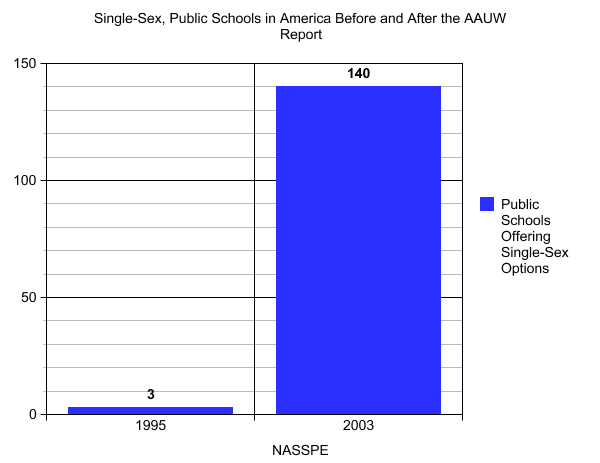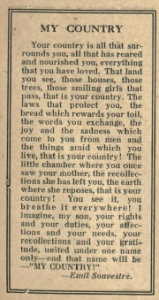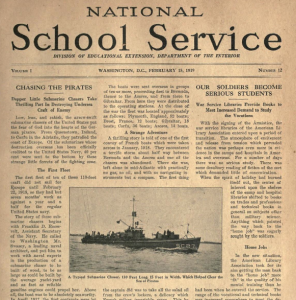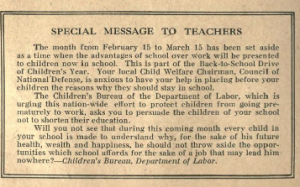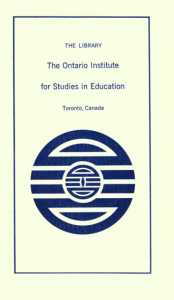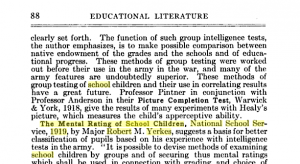Single - Sex Success; An Education for the Nation?
Public, single-sex education is a highly debated topic throughout America. The benefits and drawbacks of such a method are critiqued and analyzed, in search for the ultimate education system which creates the best learning environment for students. In the past few decades, two instrumental events in the battle over single sex education were the 1998 AAUW (The American Association of University Women) report and the 2006 shift in Title IX federal guidelines. The report casts a negative light on single-sex education, whereas the guidelines created leeway for single sex schooling to take root in public schools. Both of these occurrences impacted the societal perception of single-sex education, and the actions of law and policy makers; namely, deciding what single-sex opportunities would be available to the public. The 1998 AAUW report and the 2006 shift in federal guidelines were dramatic turning points for National, public, single-sex education; However, throughout the national debates sparked by both these instances, Hartford has lagged behind in implementing single-sex scholastic changes. Compared to the National average, Hartford has not fleshed out all possible options for single-sex education. Hartford is lacking in the options that it offers for students to attend single sex schools, most notably after the two important shifts in history listed above. The question lingers: How and why has single-sex public education evolved in Hartford, in comparison to the nation, since the 1998 AAUW report and the 2006 shift in federal guidelines? The 1998 AAUW report and the 2006 shift in federal guidelines were dramatic turning points for National, public, single-sex education; However, throughout the national debates sparked by both these instances, Hartford has lagged behind in implementing single-sex scholastic changes.
“Public schools in America are in crisis. Students are dropping out in record numbers, standardized test scores are failing, illiteracy rates are high, and the demand for remedial education programs for adults has increased,[1]” states Amy Bellman at the start of her 1997 book, Young Women’s Leadership School: Single-Sex Public Education after V.M.I. At this time in history, public, single-sex education had captured the attention of the nation through the Supreme Court Case, United States v. Virginia et al. The case called into question the legality of a publicly funded school, Virginia Military Institute, refusing the admission of women; the college stood as a male-only institute since it was founded in 1839[2]. The issue became whether or not the school would stop collecting public funds, begin accepting women at VMI, or create an equal counterpart for women. Though the school proposed a plan to create a similar program for women at Mary Baldwin College, the Supreme Court ruled that the counterpart was not “comparable” to the men’s program. According to National Association for Single Sex Public Schools,
“As the majority opinion made clear, and as Justice Rehnquist stressed in his concurrence, “comparable” does not mean “identical.” The Court found the program at Mary Baldwin college to be not comparable to the VMI program, not because VMI had a football stadium etc. and Mary Baldwin didn’t, but because the difference in funding was so large. Bottom line: “comparable” means “costing about the same amount of money”.[3] “
This case set the precedent that public schools admitting only boys or girls must have a monetarily comparable counterpart. The nation responded to this decision with various outcries from sectors ranging from women’s rights activist groups to parents whom are pro school choice.
One organization that responded to the VMI court case was the AAUW, American Association for University Women. The AAUW released a report in 1998, a year and a half after the decision of the court case, entitled, “Separated By Sex: A Critical Look at Single-Sex Education for Girls.” The report argued that single-sex education is not actually a better learning environment for girls. Furthermore, Separated By Sex makes various claims in an attempt to convince scholars and researchers that single-sex education does not live up to its expectations. For example, the report argues that, “There is no evidence that single-sex education in general “works” or is “better” than coeducation,[4]” and that “The long-term impact of single-sex education on girls or boys is unknown.[5]” The report expands on these statements by claiming that regardless of how a classroom would separate students by gender, the absence of sexism will never truly exist. With the intention of convincing scholars and academics of the findings within the AAUW report, this literature provides a look into the counterargument in order to discredit its logic. Citing the findings of James Coleman’s The Adolescent Society, the report insinuates the drawbacks of attending an academic environment, “governed by cars and the cruel jungle of rating and dating[6]” (21). The report goes on to say that Coleman’s findings suggest that single-sex schools provide a more effective learning environment by severely reducing the “competition for adolescent energies” which dominate co-education environments. Namely, Coleman’s argument focuses on the emphasis placed on the developing sexual relations between boys and girls, distracting from the academic environment and hindering scholastic achievement. These claims are backed by statistics of improved of standardized test scores in single-sex environments. However, the AAUW reports that: “…differences in scores [can be attributed] to factors such as the selectivity of the school or the socioeconomic advantages of those parents opting for single-sex education[7]” (34). This report claims that there is no actual proof that the separation of sexes results in better test scores. This insinuates that parents in the position of school choice are of a higher socioeconomic class than those who do not, regardless of whether or not all of these institutions are public. In sum, the AAUW 1998 report called out single-sex research as flawed and incomplete, challenging the integrity of single-sex schools and garnering national attention to the debate.
After the release of the AAUW report, the nation responded hastily. Schools around the country began experimenting with single-sex classrooms, some converting to the single-sex format entirely. Benjamin Wright, who was serving as the chief administrative officer for the Nashville public schools at that time, stated, “Coed’s not working. Time to try something else.[8]” In 1999, Wright was sent to Seattle to take over Thurgood Marshall Elementary School, which was considered “failing.” In hopes to revive this school, Wright took note of the staggering statistics of suspensions, expulsions and special-education enrollment of girls versus boys. Wright concluded that a single-sex environment may benefit these students socially, and thereby scholastically, by showing a more individualized approach to students and their learning. Effective in this endeavor, Wright boasts, “…the percentage of boys meeting the state’s academic standards rose from 10 percent to 35 percent in math and 10 percent to 53 percent in reading and writing” (Weil, 2008). In 2001, three years after the AAUW report, single-sex education was instituted into the legislation of the No Child Left Behind. NCLB was passed on January 8th, 2002[9]. The summary of the single-sex section of this bill states:
“On January 8, 2002, the President signed into law the No Child Left Behind Act of 2001, which reauthorized the Elementary and Secondary Act of 1965. Section 5131(a)(23) of the Elementary and Secondary Education Act allows local educational agencies (LEAs) to use Innovative Programs funds to support same-gender schools and classrooms consistent with applicable law. It also requires the Department, within 120 days of enactment, to issue guidelines for LEAs regarding the applicable law on single-sex classes and schools. This notice fully implements Congress’s mandate by describing and explaining the current statutory and regulatory requirements relating to single-sex classes and schools.”
This legislature made it legal for public, government funds to go directly to the establishment of single-sex classrooms and schools. A monumental step for single-sex education, the number of public, educational institutions offering a single-sex skyrocketed. The following is a table presenting data collected by the National Association of Single Sex Public Education, representing numbers out of 93,000 public elementary and secondary schools in America.
The data reveals that in 1995, before the AAUW report, only three out of 93,000 public elementary and secondary institutions in America offered a single-sex alternative to the typical classroom structure. The AAUW report did not effectively influence America to discredit research on single-sex public schools, but actually resulted in a serious increase in national interest on the matter. This lead to a serious leap in the public, single-sex opportunities the nation strove to offer.
Before the AAUW report, there were no public, single-sex opportunities in Hartford. Though many cities throughout the Nation began implementing single-sex opportunities, Hartford was not one of them. In the 1997-1998 school year, Hartford public schools were spending an average of $10,835 per student.[11] The following year, Hartford reportedly spent $12,013 per pupil. During the 1999-2000 school year, Hartford spent $12, 365. Even with these budget increases of $1,530 more per student over the course of three years, there was no experimentation with single-sex education.
In 2006, there was a shift in the Federal Guidelines of Title IX that defined both the policy of public funds allotted to develop single-sex classrooms and schools as well as methods for implementing a co-educational environment using government monies. This legislature is regarded as, “…the most significant policy change [in education] since a landmark federal law barring sex discrimination in education more than 30 years ago.[12]” The guidelines stated that schools can include only boys or girls in a classroom because it enhances the academic achievement of students. However, schools are not required to offer any single-sex programs, and only students who choose to participate will be enrolled. These policy makers whom stood behind these guidelines believed that by making the process of creating a single-sex environment easier for school officials, cities falling behind nationally in test scores would be able to find a solution.
After the 2006 shift in federal guidelines, single-sex, public education got extreme national attention. Though many cities were utilizing these new standards to create single-sex opportunities for students, some organizations spoke out against the new regulations. The Feminist Majority Foundation, for example, released a report entitled, Single-Sex Education, Fertile Ground for Discrimination. This report argued that, “In the classroom, separating boys and girls can reinforce stereotypes[13]” and “The weaker 2006 regulations have opened the door to discrimination.[14]” Yet regardless of outcries labeling the new regulations as a violation of rights and a gateway to discrimination, the nation increased their level of public, single-sex opportunities over the course of the next four years.
In 2003, three years before the 2006 shift in federal guidelines, only 140 schools out of approximately 93,000 schools offered single-sex opportunities. Yet in 2010, only four years after shift in Title IX federal guidelines made single-sex education easier to implement in schools, this number more than tripled. The 2006 shift in federal guidelines severely impacted the number of national public, single-sex opportunities for students.
A year and a half after the 2006 shift in federal guidelines, the city of Hartford finally began to join the public, single-sex education movement. The first single-sex classroom was quickly founded in Hartford at Fox Middle School, but this program soon closed due to insufficient city funding. Yet in late 2006, Dr. Steven Adamowski became superintendent of Hartford Public Schools. He brought to office a plan based on two principles. The first of his ideologies was school choice, and the second focused on “Managed Performance Empowerment (MPE),” which gives schools both more control and responsibility to ensure good test scores and graduation rates. A large part of this plan focused on student-budgeting, which would allow schools to plan their budget more appropriately around student to school ratio[16]. In 2008, two years after Adamowski, took office, the “Per Pupil Amounts for Current Spending of Public Elementary-Secondary School Systems” rose to $16,841[17]. With this increase in per pupil ratio, Hartford started to look at options for public, single-sex education. According to a Hartford Courant article published by Rachel Gottlieb Frank in March of 2008, “Hartford is poised to jump headlong into single-gender education, with an all-boys school being planned for the fall and a girls’ school to follow a year later.[18]” The all-boys classroom which had taken root in Fox Middle School, would soon be transformed into the Benjamin E. Mays Academy for boys, a public school devoted solely to the education of young male students. An institution for girls was in the words as well, and planned to be implemented the following year. A year later, in 2009, Grace Academy, a public, all girls school for students in grades 5-8 was also founded in Hartford. Since the 2006 shift in federal guidelines, Hartford has done more to implement public, single-sex education within the city. However, it still pales in comparison to the changes made across the nation.
Though Hartford has created public, single-sex opportunities of schooling for students over the past few years, the change is not significant enough to match the national average. Though the nation began implementing public, single-sex options for students after the AAUW report in 1998, similar opportunities were not offered in Hartford. It wasn’t until the shift in federal guidelines in 2006 that Hartford began to make a small change, as the nation made a extremely notable leap in the public, single-sex education available. With greater funding spent per pupil, single-sex education is more plausible in Hartford. In the 2010 fiscal year, the nation spent on average $10,615 per student in the public school system[19]. Therefore, with more money per student going to Hartford schools than the national average, Hartford should be able to better compete with the national statistics for public, single-sex education.
[1] Bellman, Amy B., Young Women’s Leadership School: Single-Sex Public Education after V.M.I., Wis. L. Rev. 827 (1997), (Introduction, p.g. 1)
[2] The National Association for Single-Sex Public Education, 2006-2013, http://singlesexschools.org/policy-vmicase.htm
[3]The National Association for Single-Sex Public Education, 2006-2013, http://singlesexschools.org/policy-vmicase.htm
[4] Separated By Sex: A Critical Look at Single-Sex Education for Girls. Rep. Washington, DC: American Association of University Women Educational Foundation, 1998. Web. <http://www.aauw.org/files/2013/02/Separated-By-Sex-A-Critical-Look-at-Single-Sex-Education-for-Girls.pdf>.
[5] Separated By Sex: A Critical Look at Single-Sex Education for Girls. Rep. Washington, DC: American Association of University Women Educational Foundation, 1998. Web. <http://www.aauw.org/files/2013/02/Separated-By-Sex-A-Critical-Look-at-Single-Sex-Education-for-Girls.pdf>.
[6] Separated By Sex: A Critical Look at Single-Sex Education for Girls. Rep. Washington, DC: American Association of University Women Educational Foundation, 1998. Web. <http://www.aauw.org/files/2013/02/Separated-By-Sex-A-Critical-Look-at-Single-Sex-Education-for-Girls.pdf>.
[7] Separated By Sex: A Critical Look at Single-Sex Education for Girls. Rep. Washington, DC: American Association of University Women Educational Foundation, 1998. Web. <http://www.aauw.org/files/2013/02/Separated-By-Sex-A-Critical-Look-at-Single-Sex-Education-for-Girls.pdf>.
[8] Weil, Elizabeth. “Teaching Boys and Girls Separately.” The New York Times. The New York Times, 02 Mar. 2008. <http://www.nytimes.com/2008/03/02/magazine/02sex3-t.html?pagewanted=all>.
[9] No Child Left Behind (NCLB) Act of 2001, Pub. L. No. 107-110, § 115, Stat. 1425 (2002).
[10] The National Association for Single-Sex Public Education, 2006-2013, http://www.singlesexschools.org/schools-schools.htm
[11] National Census, Public Elementary and Secondary Education Finances Per Year, http://www2.census.gov/govs/school/98tables.pdf
[12] – Schemo, Diana J. “Federal Rules Back Single-Sex Public Education.” The New York Times [New York City] 25 Oct. 2006
[13] Single-Sex Education, Fertile Ground for Discrimination, Feminist Majority Foundation, 2006, http://www.feminist.org/education/pdfs/TitleIX40Single-SexNCWGE.pdf
[14] Single-Sex Education, Fertile Ground for Discrimination, Feminist Majority Foundation, 2006, http://www.feminist.org/education/pdfs/TitleIX40Single-SexNCWGE.pdf
[15] The National Association for Single-Sex Public Education, 2006-2013, , http://www.singlesexschools.org/schools-schools.htm
[16] Funding a Better Education, Achieve Hartford, 2012, Achieve Hartford!, Hartford, CT http://hartfordinfo.org/issues/wsd/Education/Funding_a_Better_Education.pdf
[17] National Census, Public Elementary and Secondary Education Finances Per Year, http://www2.census.gov/govs/school/08f33pub.pdf
[18] FRANK, RACHEL G. “Boys School In Works For Fall Hartford Planning To Relaunch Benjamin E. Mays Academy, Establish An All-Girls School Next Year.” The Hartford Courant [Hartford] 9 Mar. 2008: n. pag. Print.
[19] Gumbrecht, Jamie. “Which Places Spent Most per Student on Education?” Schools of Thought RSS. CNN, 21 June 2012. <http://schoolsofthought.blogs.cnn.com/2012/06/21/which-places-spent-most-per-student-on-education/>.
